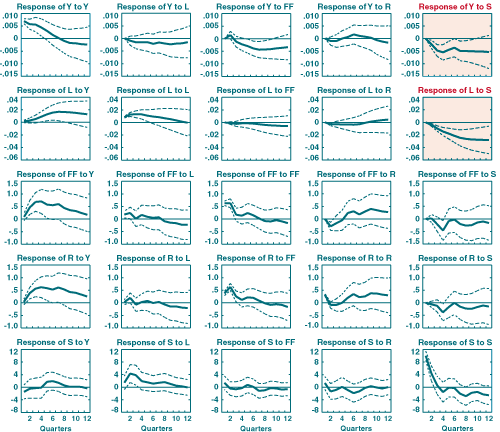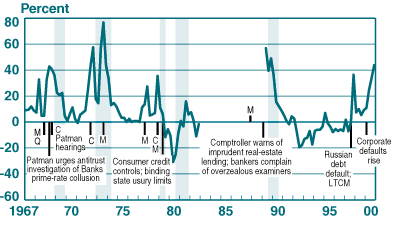| Recapping an article from the May 2002 issue |
|
||
| of the Economic Policy Review, Volume 8, Number 1 | View full article |
||
|
|
19 pages / 273 kb | ||
|
Authors: Cara S. Lown and Donald P. Morgan |
Disclaimer | ||
| Index of executive summaries |
|
Overview The authors investigate the importance of credit effects in the transmission of monetary policy. They ask, do bank lending standards "matter" for the economy—that is, do standards affect loan growth and, more broadly, GDP? The authors also explore whether credit standards are independent of the monetary policy process or, alternatively, a channel through which policy affects spending and the real economy. The analysis yields three principal findings: First, changes in credit standards have a significant effect on both loans and GDP. Second, credit standards appear to be largely independent of the monetary policy process, showing little sensitivity to changes in the Federal Reserve's key policy instrument, the federal funds rate. Third, some part of the observed impact of monetary policy on GDP may actually be disguised credit effects. Background Traditional accounts of monetary policy explain only a small part of the influence of the federal funds rate on business investment, consumer durables, and other interest-sensitive sectors of the economy. Taking credit effects more fully into account may help explain the mechanisms by which policy is transmitted to all of these areas. Some economists, in fact, have argued for the existence of a "bank lending channel" of policy transmission. In this view, a rise in the funds rate will constrain bank lending and hence curb spending by firms and households. Lown and Morgan evaluate the evidence for a lending channel and, in addition, consider how more direct policy actions to limit bank credit availability—for example, the use of interest rate ceilings and credit controls—affect loans and the economy. Argument and Methodology To examine the role of credit effects, the authors first estimate a baseline macroeconomic model that includes real GDP, the federal funds rate, commodity prices, and two credit variables—outstanding commercial loans at banks and the commercial loan rate. They then estimate an augmented model that includes a third credit variable, bank lending standards, as a measure of credit availability. This measure, based on data from the quarterly Federal Reserve's Senior Loan Officer Opinion Survey, is calculated as the net percentage of banks reporting that they have tightened their standards for commercial loans since the previous quarter. The sample period for the estimations extends from 1967 to 1983 and from 1990 to 2000, omitting the years for which data on standards are unavailable. By comparing the results obtained from the two models, the authors are able to evaluate the economic importance of credit standards. Although no strong correlation exists between the commercial loan rate and loan growth in the baseline model, credit standards prove to be highly significant in explaining loan growth in the augmented model. Moreover, the augmented model shows credit standards to be highly significant in explaining output growth. The model results also allow the authors to assess whether monetary policy works through credit variables to influence the economy. Changes in the federal funds rate do not lead to changes in lending standards in the augmented model, nor to changes in loans in either the baseline or the augmented model. This evidence, the authors note, runs counter to the notion of a lending channel of monetary transmission. The authors explore these issues further by using impulse response analysis to track the dynamic interactions of the model variables. The results confirm that credit standards do indeed matter: an unanticipated 10 percent net tightening of standards in the augmented model causes output to fall 0.5 percent at its trough and loans to contract more than 2percent (chart). According to the authors, these substantial effects in part reflect policymakers' active interventions in the credit markets—in the form of credit controls, interest rate ceilings, and similar strategies—in the 1960s, 1970s, and 1980s (chart). Nevertheless, even after 1990, when market intervention becomes less common, standards appear to retain their importance for output. The impulse response analysis also sheds light on the relationship of monetary policy, output, and credit standards. The authors find that an unexpected change in the federal funds rate—that is, a monetary policy shock—has no significant effect on lending standards. This result casts further doubt on the narrow lending channel hypothesis and suggests that credit standards are independent of the monetary policy mechanism. More important, the authors find that a policy shock has a markedly smaller effect on output in the augmented model than in the baseline model. The fact that the importance of policy shocks diminishes when credit standards are taken into account leads the authors to argue that part of the impact of monetary policy may in fact be disguised credit effects. Findings Lown and Morgan conclude that lending standards can significantly affect the growth of both loans and output. Indeed, the authors suggest that some of the changes in output attributed to monetary policy shocks may in fact stem from changes in credit standards. The authors also present evidence against a narrow lending channel of monetary transmission. Because policy shocks have no significant effect on lending standards in the model simulations, it appears that these standards affect output independently of the monetary policy mechanism. The authors caution, however, that their findings do not rule out the possibility that lenders tighten their standards when firms' balance sheets weaken—a development that might be related to changes in monetary policy. |
|
|
|
|
|
|
| Impulse Responses to a Monetary Shock over Different Samples | |
 Source: Authors’ vector autoregression (VAR) analysis using data sources in the appendix table. Source: Authors’ vector autoregression (VAR) analysis using data sources in the appendix table.
Notes: The panels depict the response to one standard deviation. Innovations are plus or minus two standard errors. The VARs comprise four lags of: Y = log GDP, P = log GDP deflator, PC = log commodity prices, L = log commercial and industrial (C&I;) loans, FF = the federal funds rate, R = the C&I; loan rate, and S = the net percentage of lenders tightening C&I; standards. The order of variables in the VARs is the order reported above. A continuation of this chart can be found in Chart A2. |
|
|
|
|
Significant Monetary and Credit Events and the Associated Changes in Standards  Sources: Romer and Romer (1989); Owens and Schreft (1995); Wojnilower (1980). Sources: Romer and Romer (1989); Owens and Schreft (1995); Wojnilower (1980).
Notes: The shaded bands indicate periods designated national recessions by the National Bureau of Economic Research. M = monetary tightening (Romer and Romer 1990), C = credit action (Romer and Romer 1993), Q = binding Regulation Q ceiling on deposit rates, and LTCM = Long-Term Capital Management hedge fund. |
|
|
Commentary on article by John C. Driscoll |
|
| Disclaimer | |
|
The views expressed in this article are those of the authors and do not necessarily reflect the position of the Federal Reserve Bank of New York or the Federal Reserve System. |
|










